Sharp NAR0061 GSM 900/1800/1900 Cellular Telephone w/ BT User Manual Manual
Sharp Corporation GSM 900/1800/1900 Cellular Telephone w/ BT Manual
Sharp >
Manual
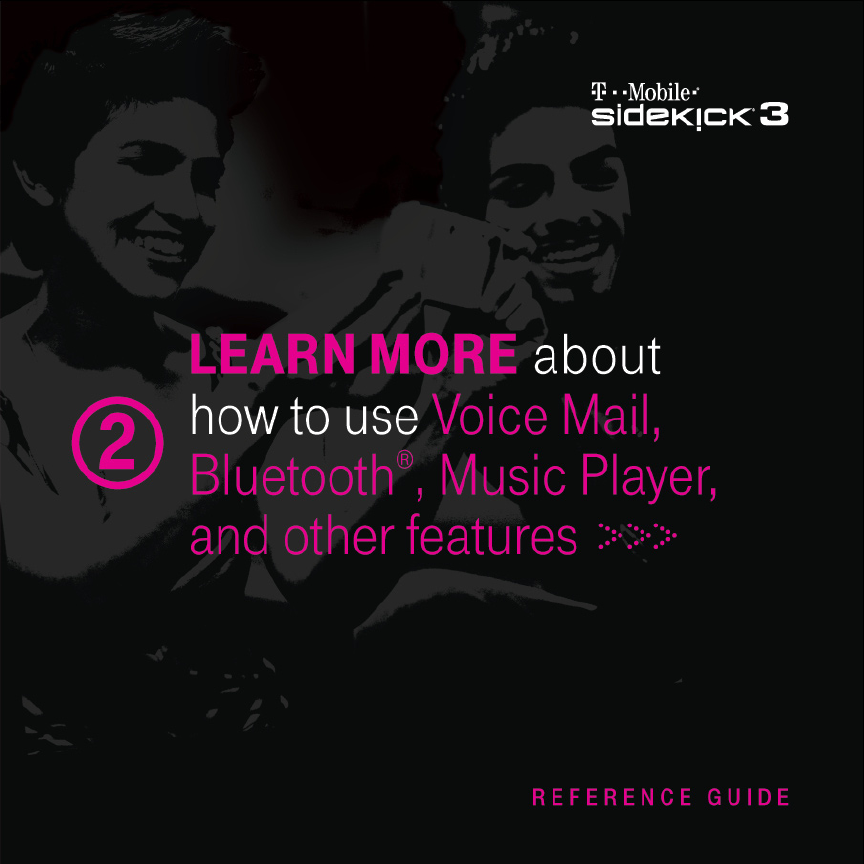
Sidekick 3
Reference Guide
27-3017-01 Rev. 01 - Release 3.1 - 23th August 2006Release 3.1 - 23th August 20063.1 - 23th August 2006
Copyright © 2006 Danger, Inc. All rights reserved.
2 Contents
Contents
Welcome! 6
I. Device Basics 8
Opening and Closing the Display 8
Phone Controls 9
Control Buttons 11
Sound Controls 13
Mini Music Player 13
Volume Controls 14
Wireless On/Off Control 14
Display Controls 15
Battery Charger 15
Removable Battery 17
SIM Card Slot 18
Memory Card Slot 18
USB 1.1 Port 19
Wrist Strap Holder 19
II. Registration 20
III. Setting Up Your Device 24
Bluetooth® Technology Setup 24
Backgrounds 25
Backlighting 25
Key Guard Mode 26
Enter Key Guard Mode 26
Change Default Key Guard Idle Time 26
Device Privacy Code 27
Sound Profiles 27
Application Customisation 28
Default Locale (Language) Setting 28
IV. The Device Interface 29
The Jump Screen 29
Menus 30
Title Bar and Indicators 31
Type and Edit Text 33
Navigate in Text Boxes 33
Delete Text 33
Cut, Copy, Paste, Undo 34
AutoText 34
Type Special Unicode Characters 35
V. The Desktop Interface 36
VI. Using the Applications 38
Phone
Make a Phone Call 38
Use Bluetooth Hands-Free Headset or Car Kit 39
Answer a Phone Call 39
Add a Number to Your Speed Dial List 40
Contents 3
Check Your Voice Mail 40
Change Your Phone Ringtone 41
Import Contacts from Your SIM Card 41
Text Messaging
Send a Text Message 42
Web Browser
Browse the Web 43
Bookmark a Web Page 43
E-mail
Send an E-mail Message 44
Get E-mail from External Accounts 44
Get E-mail Using Your Device’s Web Browser 48
Attach a Photo to an E-mail Message 48
Address Book
Add a Contact to the Address Book 49
Import Address Book Contacts 50
Set and Send “My vCard” 51
Send any Contact’s vCard 52
Calendar
Add an Event to Calendar 52
Notes
Create a Note 53
Send a Note 53
To Do
Add a Task 54
4 Contents
Camera
Take a Photo 54
Send Photos by E-mail or Multimedia Message 55
SonicBOOM Music Player
Copy Music to the Memory Card 56
Play Songs 57
Create a Playlist 58
Catalogue
Download Items from the Catalogue 59
Manage Your Downloaded Items 60
Multimedia Messaging
Send a Multimedia Message 61
Instant Messaging
Sign On 62
Send an Instant Message 63
Switch Between IM Conversations 63
VII. Keyboard Shortcuts 64
VIII. Troubleshooting 65
IX. Handling and Safety Precautions 69
Battery Handling 69
Device Handling and Use 70
Battery Charger Handling 71
X. Regulatory and Compliance Information 72
Contents 5
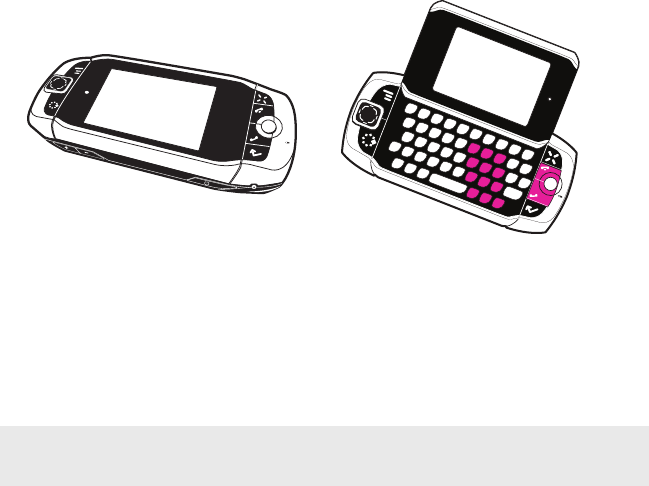
Note
Welcome!
Thank you for buying a Sidekick 3 device. Your Sidekick will change
the way you communicate, get organised and stay connected.
Your Sidekick connects seamlessly to wireless networks, allowing
you to browse the Internet, exchange instant messages and send and
receive e-mails with image attachments and multimedia messages
with voice notes. Other features include a full-featured phone,
personal information management (PIM) applications, access to
a personal Web portal (the “Desktop Interface”), entertainment
applications, a built-in megapixel camera, and a music player.
For the latest instructions, open the online version of this Reference
Guide by clicking Help on the Desktop Interface.
6 Welcome!

Welcome! 7
This is what you will find in the box:
Sidekick 3 device
Removable battery
USB cable
Battery charger (wall adapter)
Hands-free stereo headset
Wrist strap
Carrying case
Sidekick Start Guide
Sidekick Reference Guide
If any of these items are missing, please contact T-Mobile’s Customer Care
Department.
Now, let’s get started!
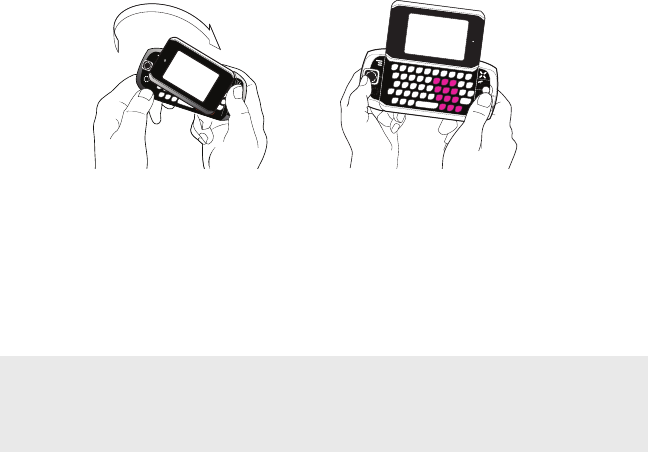
Warning
Device Basics
Opening and Closing the Display
To open the display, press your left thumb on the lower-left corner of the
display and gently push up in a clockwise direction. The display will spring
smoothly into the open position.
Alternatively, use your right index finger to push down gently on the upper-right
corner of the display. The screen will spring into the open position.
The normal operating position of the device is horizontal, with the trackball on the
right, as shown above.
To close the display, reverse the motion to pivot the display counter-clockwise and
snap it into the closed position.
Do not open or close the display in the wrong direction as this may damage your
device. Stop if you feel any resistance; the display should spring smoothly into
position. Protect the display from scratches by always using the carrying case to
transport your device.
I.
8 Device Basics
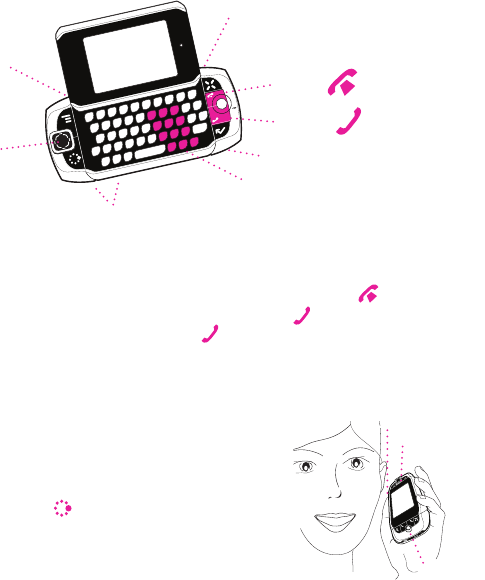
Phone Controls
VOLUME BUTTONS + -
DIAL PAD
SEND CALL
END CALL
MUTE BUTTON
(while on phone)
HEADSET
DIAL PAD Use the keyboard dial pad to dial a number with one hand.
END CALL and SEND CALL buttons During a phone call, press to end the call
or to clear the screen of a number you’ve typed. Press to call the phone number
you’ve typed or highlighted in a list. Press with no number typed to display a list
of recently-dialled numbers.
SPEAKER When using the device as a handset, place the
speaker to your ear.
MICROPHONE When you are using the phone,
speak into the microphone.
VOLUME buttons The volume buttons are
located under the JUMP button. While on a
phone call, press + to increase and - to
decrease volume. Use the shoulder buttons
to turn Mute or Speakerphone on and off.
Device Basics 9
SPEAKERPHONE BUTTON
(while on phone)
SPEAKER
SPEAKER
VOLUME BUTTONS
MICROPHONE

Note
10 Device Basics
BLUETOOTH HANDS-FREE HEADSET OR CAR KIT To use a Bluetooth hands-free
headset or car kit, do the following:
1 Press JUMP to open the Jump screen. Press MENU to open the menu, then
select Bluetooth to open the submenu. Make sure Bluetooth features are “on”.
(There should be a Turn Bluetooth Off menu item.)
2 When you are in your car, make sure your hands-free headset or car kit is ready
to pair by following the manufacturer’s instructions. On your Sidekick, go into
the Phone application. Press MENU and select Settings > Pairing.
3 From the Pairing dialog box, select your Bluetooth hands-free headset or car
kit from the list of devices (you may have to wait a few seconds while the list
populates with Bluetooth devices). If prompted, type the device’s PIN code,
then press DONE to dismiss the PIN Code dialog box.
4 By default, your call’s sound will go through the device handset. To send or
receive your call using a Bluetooth device, press MENU and select Transfer
Sound to, then select your Bluetooth device from the submenu.
You can transfer the call’s sound either before or during a call.
5 Place your call.
6 When finished with your call, press END CALL .
STEREO HEADSET Always connect your stereo headset to your device before
making/receiving a call. To use the button:
n Press the button once to answer a call and a second time to end it.
n During a call, press once to answer a second incoming call and put the first
caller on hold.
n With two active calls, press the button once to end the foreground call and press
again to resume the background call.
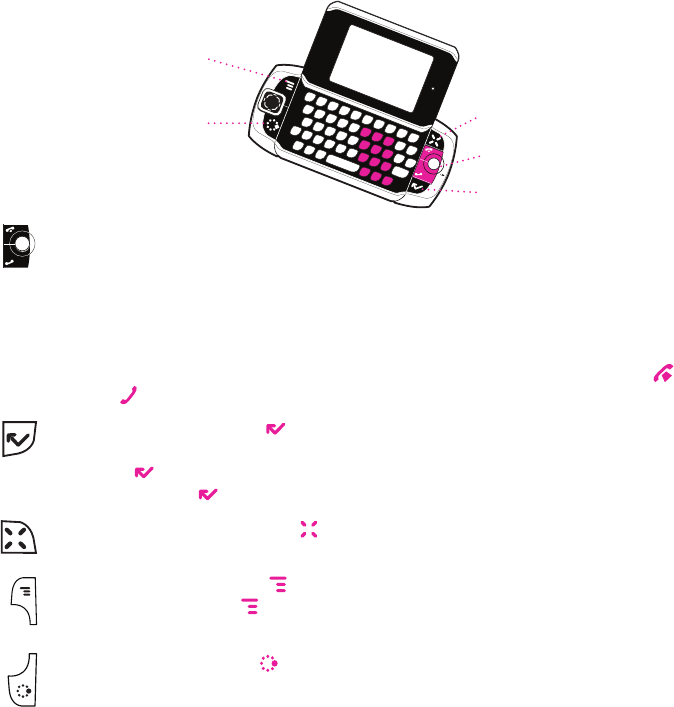
Control Buttons
MENU
JUMP
TRACKBALL + SEND/END
CANCEL
DONE
TRACKBALL Pressing the trackball selects a highlighted item or opens a pop-
up menu. Roll the trackball up/down/left/right to reverse/advance the current
selection through the “selectable” items on a screen or Web page. Rolling the
trackball right/left with a folder highlighted will open/collapse the folder contents.
Adjust the vertical and horizontal speed of the trackball from the Jump Menu >
Settings > Trackball screen.
SEND/END buttons When not using the phone, press these buttons to page up
or down .
DONE button Pressing DONE takes you back through the screens you were
previously viewing, until you reach the Jump screen. On a screen or in a dialog box,
press DONE to save your changes and dismiss the screen or dialog box. If a menu
is open, press DONE to close it.
CANCEL button Pressing CANCEL dismisses any changes you have made to a
screen or dialog box.
MENU button Pressing MENU opens a menu of actions you can take on the current
screen. If you press MENU and nothing opens, this means there are no menu
actions available for the current screen.
JUMP button Pressing JUMP takes you back to the Jump screen, your starting
point for launching all the device applications.
Device Basics 11
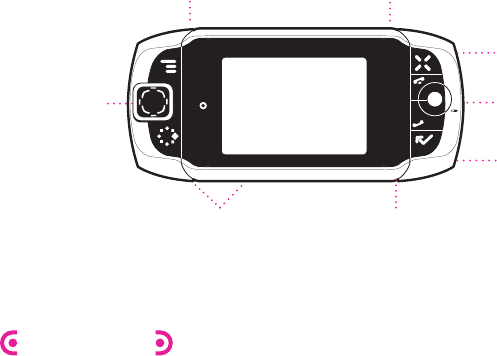
RIGHT SHOULDER
BUTTON
LEFT SHOULDER
BUTTON
POWER ON / OFF BUTTON
VOLUME BUTTONS
DIRECTIONAL
PAD
+-
USB 1.1 PORT
POWER JACK
STRAP HOLDER
DIRECTIONAL PAD (D-Pad) Press up/down/left/right to scroll or move within text
fields and navigate in games. The D-Pad “rocks” in four different directions and
generally mirrors the behaviour of the trackball.
LEFT AND RIGHT SHOULDER buttons The function of these buttons depends
on which application you’re using. For example, while using the Camera, the right
shoulder button captures a photo. While using the Phone, the left shoulder button
toggles Mute and the right shoulder button toggles Speakerphone. In the E-mail
and MMS compose screens, the right shoulder button opens your photo albums so
you can select a photo to attach to the message, and the left shoulder button opens
the voice recorder.
POWER ON/OFF button Press the Power button for three seconds to turn the
device on or off. You can also press the Power button twice (“double-tap”) to power
down.
VOLUME buttons Press and hold + or - to step through your Sound Profiles or to
increase/decrease the volume of any application you’re currently using, such as the
phone or music player.
12 Device Basics
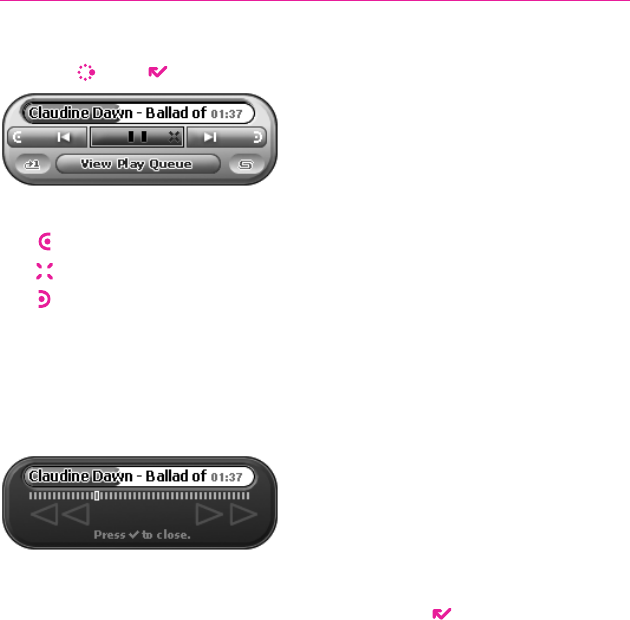
Sound Controls
Mini Music Player
To open the mini music player (transport controls) from anywhere on the device,
press JUMP + DONE .
Use the trackball to highlight a control, then press to perform the action:
Play previous song
Pause song now playing, or resume play if paused
Play next song
To scroll through the songs in the Play Queue, roll the trackball down and select
the Play Queue pane. Roll the trackball left or right to scroll through the songs in
your queue.
To jump to a specific place in a song, roll the trackball up, then select the song title.
The player view will switch to the following:
The row of bars is referred to as the “scrubber bar”. The highlighted bar indicates
the progress of the song you are currently playing. Roll the trackball right to fast
forward, left to rewind. To exit scrubber mode, press DONE .
Device Basics 13
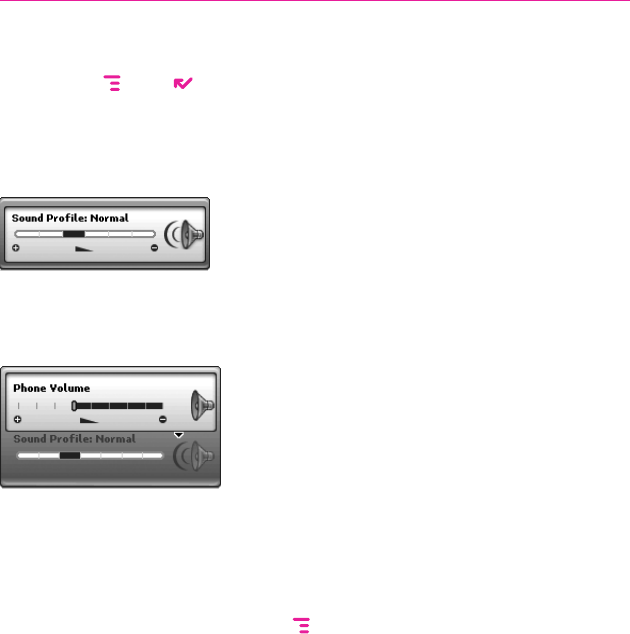
Volume Controls
There are two ways you can open the volume controls:
nPress MENU + DONE . Roll the trackball left/right to step through your
sound profiles. Left is louder, right is softer. (Read more in “Sound Profiles”
on page 27.)
nPress the + or - volume buttons on the lower-left edge of your device. Continue
pressing the buttons to step through your sound profiles:
If you are playing a song or on the phone, the volume control panel includes
separate volume controls for the music or phone call. This control is focused by
default; to change your Sound Profile, roll the trackball down to focus the Sound
Profile pane, then roll the trackball left or right to select a profile.
Wireless On/Off Control
If you need to turn off your device’s GSM, GPRS, EDGE, and Bluetooth wireless
connectivity (for example, during aircraft takeoffs and landings), proceed as follows:
1 From the Jump screen, press MENU and select Airplane Mode >
Turn Wireless Off.
14 Device Basics
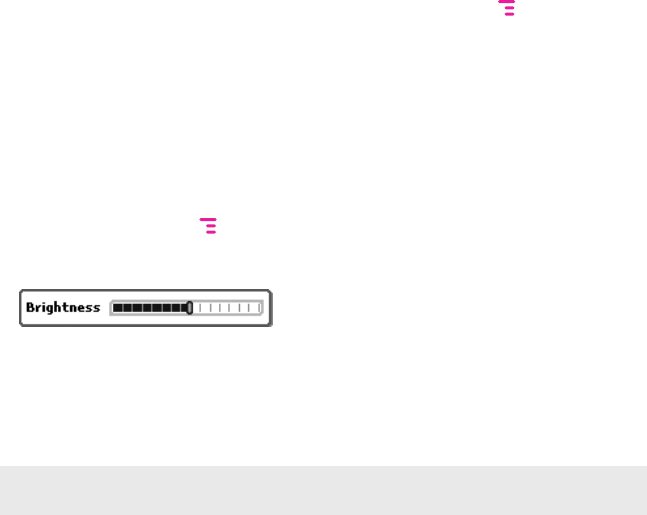
Warning
2 Your device is now offline. You should confirm offline status by looking next to
the radio tower icon in the title bar; it should read OFF.
3 To turn wireless back on, from the Jump screen, press MENU and select
Airplane Mode > Turn Wireless On.
Note that after you select the Turn Wireless On/Off menu item, it takes a few
seconds for the radio to actually turn on or off. During that time, the menu item will
appear dimmed and you will not be able to select it.
Display Controls
To adjust the display backlight brightness, open the Display Control from the Jump
screen by pressing MENU then selecting Settings > Battery & Display. Scroll
down to highlight the Brightness slider. Press the trackball to open the slider for
adjustment. Roll right to increase brightness; left to decrease.
Battery Charger
Your device comes with a removable, rechargeable lithium-ion battery. When
you first receive your device, it is important that you fully charge the battery, as
described in the following steps.
Only use the charger (wall adapter) and battery provided with your device or
approved by your wireless operator, otherwise you risk damaging your device.
1 Attach the battery charger to your device.
Locate the battery charger that came in the box with your device. Insert the
charger lead (the small round end of the cord) into your device’s power jack
Device Basics 15

Tip
(the small round hole located on the upper right side of your device) and plug
the power cord into a standard electrical wall outlet.
The orange charge indicator light will go on and a lightning bolt icon
will appear over the battery icon in the title bar, indicating the charger is
connected and the battery is charging. Note that if your device has discharged
completely, it may take up to 15 minutes before you see any indication of
charging on the screen.
2 Allow the device to charge for at least four (4) hours, until fully charged.
Rest the device in a safe place and allow the battery to charge for at least four
hours. When you first receive your device, you must fully charge the battery for
the system to perform battery-reading calibration and deliver full capacity.
As the device is charging, you will see the bars in the battery icon fill
repeatedly from left to right. When your device is fully-charged, the lightning
bolt icon will disappear and the bars will stop moving and remain in the filled
position.
For efficient operation, charge your device nightly. If you plan to leave your device
unattended for a prolonged period of time, be aware that the battery will discharge
after two days if it is turned on and not attached to the charger. If your device does
fully discharge, simply attach it to the charger; all your data should be restored.
16 Device Basics
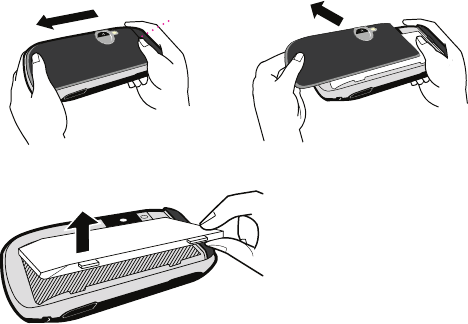
Removable Battery
If you need to replace your rechargeable battery, or if you need to insert or remove
your SIM card, first you will need to remove the installed battery. Begin by powering
down your device:
1 Press and hold the power button three seconds to power down.
2 Turn the device over. With the camera at the top, press the cover latch with
your right thumb, push the cover left to release, then lift the cover to remove it.
3 Push the battery in slightly, then lift the battery from the bottom edge and
remove.
4 Replace with a new battery by first inserting the long edge with the three tabs
and then pushing the battery down to lock into place.
5 Replace the cover. Once the battery makes contact, the power-on sequence
begins.
Device Basics 17
COVER LATCH
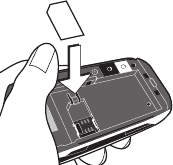
SIM Card Slot
To insert or remove your SIM card, you must first remove the battery.
1 Remove the battery cover and battery by following “Removable Battery”, steps
1-3, on page 17.
2 Note the SIM card slot, which is shaped like a SIM card and is located just to
the left of centre.
3 To insert the SIM card, slide the card into the slot with the gold contacts facing
down. Make sure the two side brackets are on top of the card, holding the card
in place.
4 To remove the SIM card, insert your nail or paper clip into the notch in the
case located next to the card in order to move the card up slightly. Then gently
slide the card out, free of the two brackets.
Memory Card Slot
Your device comes with a Mini Secure Digital (miniSD) flash memory card. To insert
or remove the memory card, you must first remove the back cover as described in
“Removable Battery”, step 2, on page 17.
1 With the back cover removed, you can see the memory card slot on the right
edge of the device.
18 Device Basics
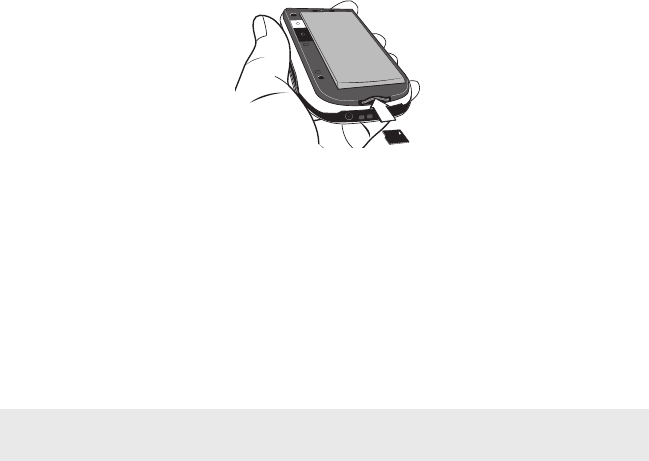
Note
2 To insert the memory card, hold the card with the gold contacts facing down
and the card notch facing toward the device. Insert the card into the slot and
push to lock into place.
3 To remove the memory card, push the card in slightly and release; the card
should spring partly out of the slot. Pull the card free of the device.
USB 1.1 Port
The USB port is located on the right edge of your device. If you have a flash
memory card inserted, you can manage the contents of the card by connecting
a USB cable to the device and your computer. The flash memory will appear as a
drive on your computer, and you will be able to add or remove music or image files
using your computer’s file system.
While your device is connected to your computer using the USB port, the memory
card contents are not available from your device.
Wrist Strap Holder
Carry your device securely by using a wrist strap with a flexible loop on one end.
Thread the loop under the strap holder and through the “tunnel” on the right edge
of your device next to the power jack.
Device Basics 19
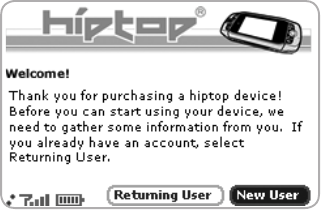
Registration
Before you can start using your Sidekick, you must complete the registration steps,
as explained in step 3 in the Start Guide. This section of the Reference Guide takes
you through the registration process in more detail. Note that these instructions are
for new users, not returning users. Returning users can simply sign in using their
existing username and password.
1 Wait for account activation.
Before you can use your account, your account must be activated. This can
take up to 24 hours, but usually takes only 1 to 3 hours. While you wait, step
through the screens that appear. If applicable, you’ll be given the opportunity
to select your language just before the Welcome screen appears. When you
see the Welcome screen, you’ll know your device has been activated:
Press the trackball to select the New User button and advance to the next
screen. On subsequent screens, select the Next button to advance.
20 Registration
II.
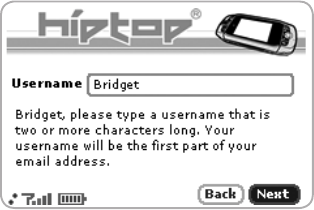
Registration 21
2 Type your first and last names.
Use the keyboard to type your First name, then roll the trackball down to
highlight the Last name field. Type your last name, scroll down to highlight the
Next button and then press the trackball to advance to the next screen.
3 Select a username.
The username you type will become the first part of your e-mail address
(for example, username@example.com). Before you select a username,
read the following guidelines:
n Usernames must start with an alphabetic character (A-Z) and can
include numbers and underscores ( _ ), but no other punctuation.
n Usernames must be at least two but no more than 32 characters long.
n Usernames are not case-sensitive. For example, if your username is
“bridget”, you will be authenticated if you sign in by typing “Bridget”,
“BRIDGET”, or any combination of upper or lower case letters.
When you have decided on a username, type it in the text box on the screen:
4 Select a password.
Select a secure password that follows the rules below:
n Passwords cannot be the same as your username.
n Passwords must contain 4-15 characters, can include both
letters and numbers, but no spaces, single quotes (‘), semicolons (;),
backslashes (\), or percentage symbols (%).
n For enhanced security, do not choose an actual word that appears in any
language dictionary. Do not choose a proper name, such as the name of
a child, your local sports team, a pet’s name, or your city of birth. Do not
choose adjacent letters on your keyboard or a sequential or repeating
combination of letters or characters, such as “12345678”, “222222”, or
“abcdefg”.
nFor enhanced security, do choose a password that is more than seven
characters long, mixes letters and numerals, and uses upper- and lower-case
letters.
n Passwords are case-sensitive. For example, if you set your password
to be “Hard2Guess”, then you will not be authenticated if you sign
in by typing “hard2guess”.
Type the password in the text box, then type it again to confirm.
5 Select your time zone.
Open the pop-up menu to see a list of time zones. Select yours from the list,
then select Next.
6 Select a “secret question” and type your answer.
If you ever forget your password, you’ll need to contact your operator’s
Customer Care representative. For security purposes, they will ask you to
provide an answer to the “secret question” you select on this screen. Press the
trackball to open the Question pop-up menu, scroll to highlight a question,
then press the trackball to select it.
Roll the trackball down to highlight the Answer field, then type your answer.
When finished, select Next to continue.
22 Registration
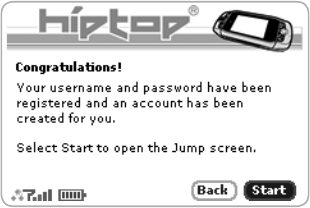
Registration 23
7 Read and accept the end-user agreement.
Before you can finish registration, you must read and agree to the end-user
agreement. You can read it by selecting the on-screen View Agreement link or
from the Desktop Interface. Once you read the end-user agreement, select the
Next button to indicate your acceptance and transmit your registration data.
8 Wait while data transmits.
Wait while the data you entered in Registration transmits to your wireless
operator. The service will check to see if your username already has been
taken. If it has, you will be offered alternatives. You can either pick one of
these alternatives or type a different username. Note that if you are out of
network coverage, you’ll be asked to “try again” to resume registration.
9 Congratulations!
Once your account has been set up,
you’ll see the
Congratulations screen:
Select the Start button to begin!

Warning
Setting Up Your Device
Bluetooth® Technology Setup
Your device supports the Bluetooth wireless technology Specification 1.2 so you
can connect to hands-free devices (headset and car kit) and any device that can
receive a vCard via Bluetooth (PCs, phones).
To turn on Bluetooth features and open the Bluetooth settings, proceed as follows:
1 Press JUMP to open the Jump screen. Press MENU to open the menu, then
select Bluetooth. The submenu opens.
2 From this submenu you can perform the following:
Pairing - Displays a list of available Bluetooth devices with which you can pair.
My Device - Rename your device (as it appears to others) and select an option
requiring that others authenticate before connecting to your device. You can
also request that the device automatically try the PINs 0000 and 1234 when
authenticating with other devices.
For maximum privacy and security, make sure you select the Require
authentication check box.
Visibility and Bluetooth On/Off - Bluetooth features are “off” by default; to
select one of the visibility options, you must first Turn Bluetooth On from the
menu. Once Bluetooth features are on, select from: Always Visible (if you
are actively using Bluetooth devices), Visible for 60sec (to exchange a vCard
quickly), and Never Visible (prevents others from sending you vCards or
pairing with you).
24 Setting Up Your Device
III.

Setting Up Your Device 25
Send My vCard - If you have set “My vCard” in the Address Book, you can send
your vCard quickly to another Bluetooth device by selecting this option or
by using the shortcut MENU + Y. Read more in “Set and Send My vCard” on
page 51.
3 With Bluetooth features on, you can also use a hands-free headset or car kit
to place and receive phone calls from your device. Read more in “Bluetooth
Hands-Free Headset or Car Kit” on page 10.
Backgrounds
To customise the backgrounds on all the application splash screens, proceed as
follows:
1 Press JUMP to open the Jump screen. Press MENU then select
Backgrounds.
2 Highlight your choice of background from the submenu, then press the
trackball to set it.
Backlighting
For better screen visibility in poor light, enable backlighting:
1 Press JUMP to open the Jump screen. Press MENU to open the menu, then
select Settings > Battery & Display.
2 Select the Turn on backlight when using device check box to enable
backlighting. Select the length of time you want backlighting to stay on from
the Turn off after pop-up menu.
3 To use the device’s light meter to detect when the backlight is not needed
(this will conserve battery life), scroll down and select the Use ambient light
sensor check box.
4 Press DONE to save your settings.
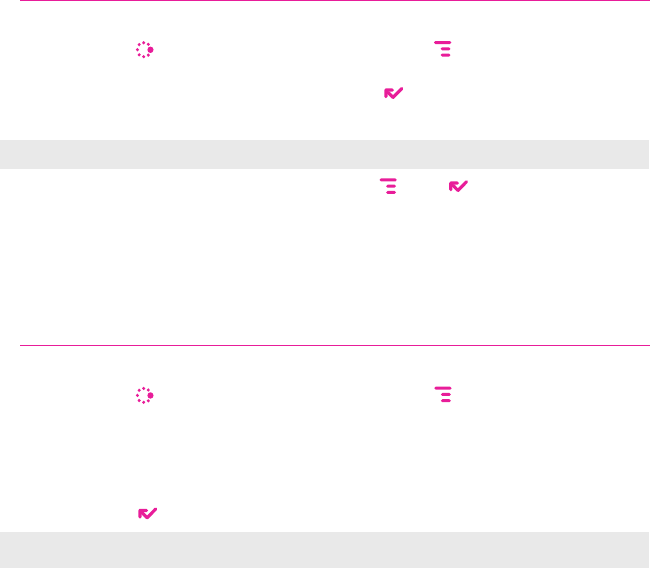
Tip
Note
Key Guard Mode
You can effectively lock the controls by entering key guard mode. By default, your
device is set to enter key guard mode after one minute of idle time.
Enter Key Guard Mode
1 Press JUMP to go to the Jump screen. Press MENU to open the menu, scroll
to highlight Key Guard, then press the trackball. You can also enter key guard
mode quickly by pressing and holding DONE for two seconds.
2 Your device control buttons lock and the key guard screen appears.
To turn on the backlight while in key guard, press the right shoulder button.
3 To unlock and wake the device, press MENU + DONE . You can also wake the
device by opening the screen. If you have set a privacy code (see next section),
type it at the prompt.
To prevent display damage, after your device has been in key guard mode for 30
minutes, a screensaver will appear. To dismiss the screensaver, press any key or
open the device.
Change Default Key Guard Idle Time
1 Press JUMP to open the Jump screen. Press MENU then select
Settings > Key Guard & Security.
2 In the Key Guard group box, scroll down to highlight the “Guard after” pop-up.
Press the trackball to open the pop-up. Highlight an idle time, then press the
trackball to select it.
3 Press DONE to save your settings and return to the Jump screen.
Your device will still receive calls and messages while in key guard mode.
26 Setting Up Your Device
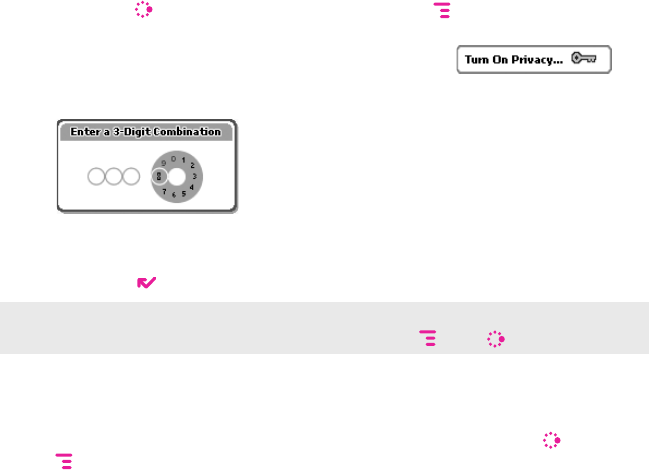
Note
Setting Up Your Device 27
Device Privacy Code
If you want to secure your device against unauthorised access once your device has
gone into key guard mode, first you must set a privacy code:
1 Press JUMP to open the Jump screen. Press MENU then select
Settings > Key Guard & Security.
2 Scroll down to the Privacy Lock group box. Highlight ,
then press the trackball to select it.
3 Enter a three-digit code using the keyboard or the dial:
At the prompt, re-enter your code to confirm.
4 A “New Combination Enabled” message appears. Select OK.
5 Press DONE to save your settings and return to the Jump screen.
You can still make emergency calls from the key guard screen even if privacy code
is enabled by opening the display then pressing MENU + JUMP .
Sound Profiles
To create a new sound profile or modify an existing profile, press JUMP , then press
MENU and select Settings > Sound Profiles. You can have up to eight profiles in
total. The system provides six profiles by default.
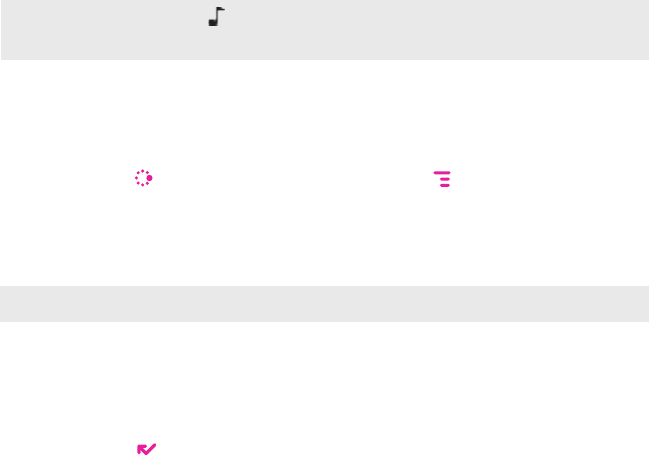
Tip
Note
Application Customisation
Set application-specific preferences using the Settings screens found within the
applications. Some of application settings you can customise include:
n Set your favourite Web home page (Web Browser)
n Select individual Caller ID icons or photos (Phone/Address Book)
n Create your own categories and labels for identifying contact information
(Address Book)
n Set different ringtones for individual callers (Phone/Address Book)
If you see a musical note next to a menu item, you will know that you can
customise that application’s ringtone setting there.
Default Locale (Language) Setting
Change the default locale for your device from the Locale Settings screen:
1 Press JUMP to open the Jump screen. Press MENU to open the menu, then
select Settings > Locale. The Locale screen appears.
2 All available locales are listed in the Language pop-up menu. Select the locale
you wish to set as your default. If your pop-up menu is dimmed, you have no
other locales available.
Your device must be restarted before a language change can take effect!
3 In the Keyboard Mapping pop-up, select a locale to which you want your
keyboard mapped. If you change the mapping, what appears on the screen
when you type may no longer correspond to the characters printed on your
keyboard. If this pop-up menu is dimmed, you have no other mappings
available.
4 Press DONE to save your setting and dismiss the Locale screen. Your device
will restart if you have changed your default language.
28 Setting Up Your Device
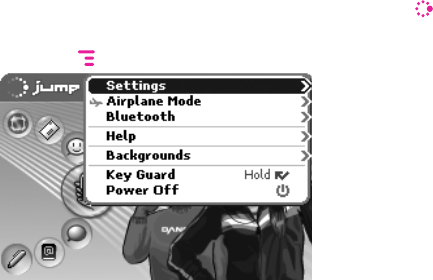
The Device Interface 29
The Device Interface
The Jump Screen
The Jump screen is your entry point to all device applications. Applications are
arranged on the left-side of the screen in a “ring”. Some applications are grouped
into a second-level folder. The Jump screen menu provides device-wide settings
and controls:
1 Go to the Jump screen from any screen by pressing JUMP . The Phone splash
screen is selected by default.
2 Press MENU from the Jump screen to open the Jump screen menu:
From this menu you can open the device-wide Settings screens. You can
also turn wireless on/off (Airplane Mode), open Bluetooth settings, open
Help (online Owner’s Manual or Connectivity Tips), select a Jump screen
Background theme, place the device in Key Guard, and Power Off.
IV.
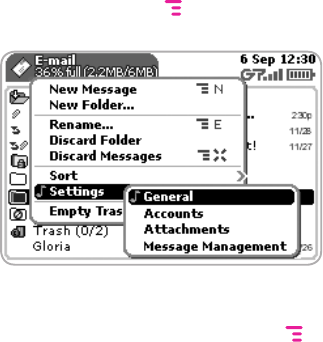
3 To select an application, scroll through the “ring” of application icons.
When the application or application folder you want is highlighted, simply
press the trackball once to open that application or to enter the second-level
application ring.
Menus
Almost every screen on your device has a set of actions you can take while on that
screen. These actions are listed in a floating window, which you open by pressing
the Menu button MENU . Menu items with submenus are noted with a right-pointing
arrowhead. The E-mail Settings submenu is shown below.
Frequently-used menu items also have keyboard shortcuts that use the Menu button
plus a shortcut key. Take a look at the menu shown above. To compose a new
e-mail message, you could press MENU + N rather than opening the menu and
selecting New Message with the trackball.
30 The Device Interface
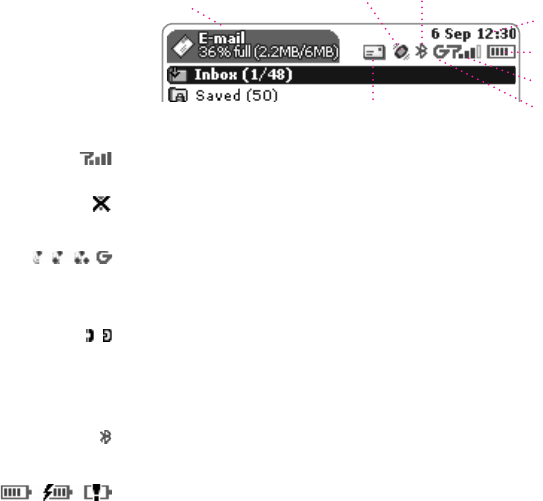
The Device Interface 31
Title Bar and Indicators
The device display indicators appear at the top of your screen at all times.
Screen Title
Battery Strength
Wireless Signal Strength
Date and Time
Service Connectivity Status
New Message Notification (E-mail)
Sound Profile Setting
Wireless signal strength indicator The number of signal bands showing to the
right of the radio tower icon represents the strength of the signal at your current
location. If you see an X flashing over the radio tower icon, you’ve temporarily lost
network connection and can make no calls.
Service connectivity indicators One dot = device is connecting to the GPRS/EDGE
network; two dots = getting IP address; three dots = connecting to the data service;
“G” = fully connected to the data service.
GSM (Phone) service only A phone icon in the place of the “G” means you are
using (or only have access to) GSM phone service. If you have a call in progress
you’ll also see a timer. If the phone icon is hollow, you can only make emergency
phone calls.
Bluetooth indicator When you see this icon just to the left of the “G”, you know that
Bluetooth features are available.
Battery indicators The number of bars showing in the battery icon represents the
charge remaining in the battery. When connected to the charger, a lightning bolt
appears and when your battery is almost fully discharged, an exclamation mark
appears.
Bluetooth On

Phone call indicators
A timer appears when you have a call in progress; in the example, call time elapsed
is 3 mins, 40 secs. Note that the phone icon blinks. If you have two calls active, the
time displayed is for the foreground call.
Call forwarding is turned on. Your phone will not ring.
Sound Profile setting When you have sound turned off (“Silent” sound profile),
the title bar will indicate whether you have flashing lights or vibration set for alerts
or notifications. From left to right, the icons indicate: totally silent (no sound, no
flashing lights, no vibration), flashing lights only, and vibration only.
Communication services notifications When you receive a new e-mail, text, IM,
MMS, or voice mail message, or when a Web page has finished loading, you’ll
see a visual “balloon” notification move across the title bar, while you’re in any
application except games.
Until you check your new message or go to your Web page, you’ll see the
appropriate icon in the title bar as a reminder. The examples shown to the left
illustrate a pending e-mail message, text message, and loaded Web page.
Memory card activity indicators
When data is being written to or from your memory card, you will see this icon
flashing in the title bar, just to the left of the date.
When you are inserting or ejecting the card, you will see the memory card icon with
an arrow; the arrow points left when inserting, right when ejecting.
USB connector icon When your device is connected to your computer using
the USB port, you will see this icon in the title bar, just to the left of the date.
Note that when your device is attached to your computer via USB, the contents of
your memory card cannot be read by the device.
32 The Device Interface

The Device Interface 33
Type and Edit Text
It’s easy to type and edit text in any text box using the keyboard and the advanced
text editing features described below.
Navigate in Text Boxes
Use the control buttons and keyboard to navigate within a text box:
n To move character-by-character, press the D-pad or roll the trackball left/right.
n To jump to the beginning/end of a word, press ALT + D-pad or trackball left/right.
n To jump to the beginning/end of a line, press MENU + trackball left/right.
nTo jump to the top/bottom of a text box, press MENU + or .
Delete Text
nTo delete a character to the left of the cursor, press the DEL .
nTo delete a character to the right of the cursor, press SHIFT + .
nTo delete all the characters on one line, press ALT + .

Cut, Copy, Paste, Undo
To cut, copy, or paste text you have typed, follow these instructions:
1 Position your text cursor next to the text you want to cut or copy.
(Use the D-pad or trackball to position the text cursor.)
2 Hold down the Shift key while pressing the D-pad or trackball in a direction.
As you select text, it is shown highlighted. (To de-select, release the Shift key
and press the D-pad or trackball in any direction.)
3 Press MENU and select Edit Text to open the Edit Text submenu, or simply
press and hold the trackball to open the Edit Text context menu. Select
the operation you want to perform on the selected text. Note the standard
shortcuts:
nCut MENU + X
nCopy MENU + C
nSelect All MENU + A
4 You can paste text that you have copied to the device clipboard to any other
text box in any application. Simply position your cursor where you want to
paste the text, then use the Paste shortcut MENU + V. (You can also open the
menu and select Edit Text > Paste.) Note that the device clipboard only stores
one set of copied or cut text at a time.
5 If you make a text edit and want to undo it, simply press MENU + Z. To redo
an undo, press MENU + Shift + Z.
AutoText
Use the AutoText feature to type text quickly and accurately:
1 Press JUMP to open the Jump screen. Press MENU to open the menu, then
select Settings > AutoText. The AutoText screen appears.
2 The screen offers automatic formatting and word replacement options you can
select. Open the menu to discard or create rules.
34 The Device Interface
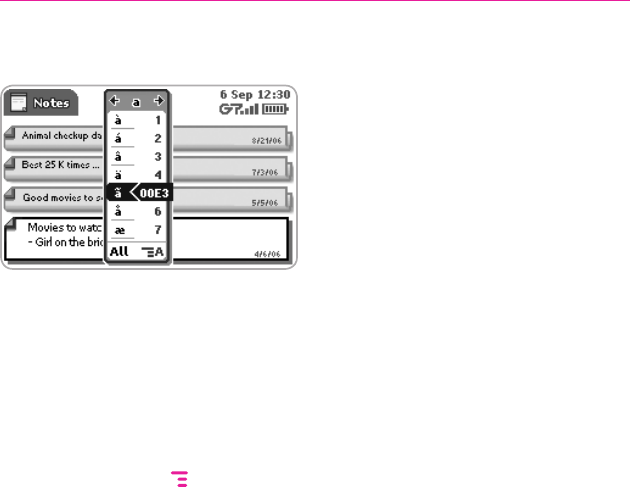
The Device Interface 35
Type Special Unicode Characters
To type special Unicode characters in any text box, press the SYM key. The Special
Character selector opens, displaying special characters alphabetically.
Use the D-pad or trackball to navigate through the list: left-right to flip through
the Favourites, Recent, alphabet, and symbol sets; up-down to select specific
characters. Press the trackball to insert a highlighted character. Here are some
useful tips in using the Special Character selector:
nWith the selector open, you can show the same characters capitalised by
pressing Shift + the character (like “a”). Toggle back to lower case by pressing
the letter again.
n To see all special characters, select All (at the bottom of the selector) or use the
menu shortcut MENU + A and the grid expands.
n To open a character set for a specific letter, press SYM + the letter.
n To type a character using its Unicode value (hover over a selection in the
selector for two seconds to see code), press SYM + Spacebar (press the keys
simultaneously), then type the 4-character Unicode value.

The Desktop Interface
The data you store in your device’s E-mail, To Do, Calendar, Address Book, Notes
and Camera applications are also available for viewing or editing on the Web from
any computer connected to the Internet. Information in your account is stored on
servers in a data centre with enhanced security and firewall features.
To reach the Desktop Interface, use the Web navigation and sign-in instructions in
the Start Guide, which is included in the box.
Once you’ve signed in, your Jump page will open. Use the Jump page navigation
buttons to open the various applications:
n Open the online Help page by clicking the Help link.
n Import existing contacts from the Address Book > Import page; import existing
Calendar events from the Calendar > Import page.
n Synchronise your Sidekick Address Book, Calendar and To Do items with
Microsoft Outlook by downloading the Intellisync application: click Settings
(next to the Help link on the top bar), then click the Sync tab and simply follow
the instructions.
n Change your default language or time zone by clicking Settings.
36 The Desktop Interface
V.
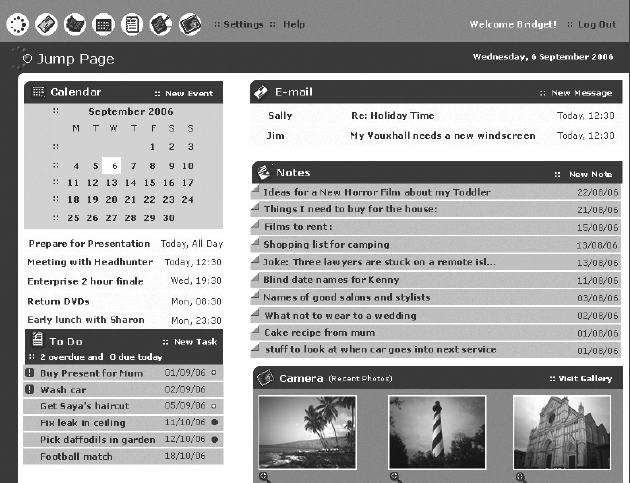
The Desktop Interface 37
Desktop Interface Jump Page
Remember! When you’ve finished using the Web applications, always click the
Sign Out link to exit the Web site securely.
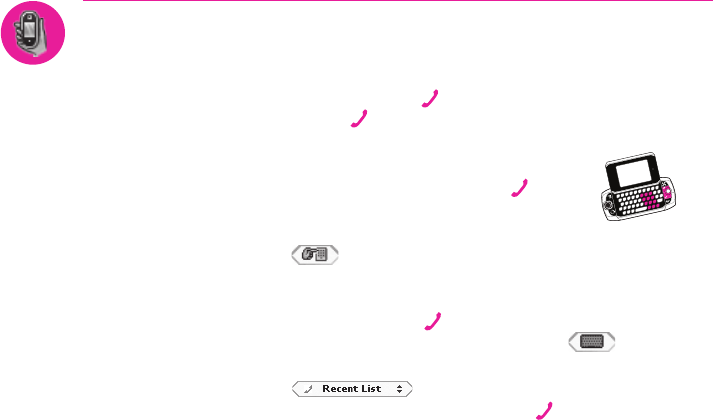
Using the Applications
The number of applications that appear on your device will vary, depending on
those offered by your wireless operator.
Phone
Make a Phone Call
1 Type the number you want to call by using any of these dialling methods:
n To dial using your list of speed dials and recently-dialled numbers: From the
Jump or Phone screen, press SEND CALL . Highlight the number, then place
the call by pressing SEND CALL .
n To dial with numbers: From the Jump screen or Phone screen, open the
display and type your number using the embedded dial pad,
or use the numbers on the top row. Press SEND CALL to
place the call.
n To dial using letters (such as 0800-LETTERS): First open the on-screen dial
pad by selecting the button on the Phone screen. Now you can use
the keyboard to type letters, and the on-screen dial pad or the number row
to type numbers (in this mode you can’t use the embedded dial pad to type
numbers). When ready, press SEND CALL to place the call. To switch back to
using the embedded dial pad to type numbers, select the icon.
n To dial using a list of recently-dialled numbers: From the Phone screen,
highlight then select . If the number you want to call is on the
list, highlight it with the trackball, then press SEND CALL . The call is placed.
38 Using the Applications
VI.
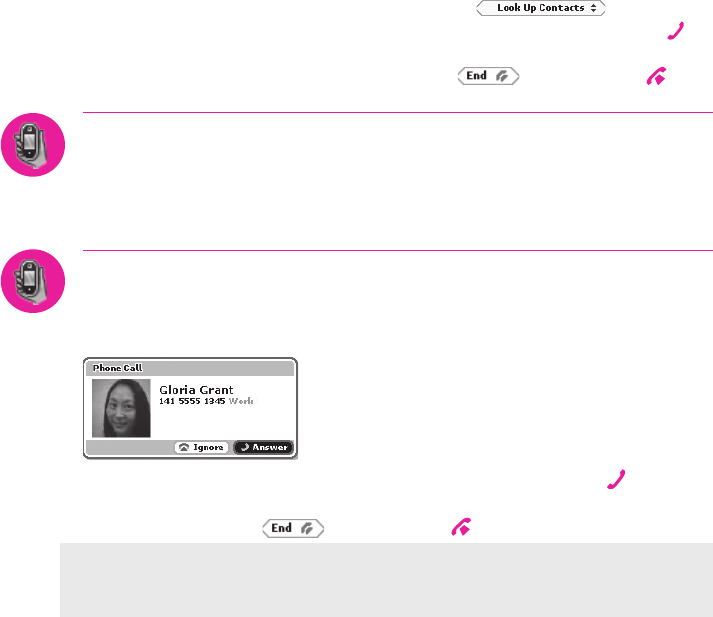
Note
Using the Applications 39
n To dial by finding a contact and phone number from your Address Book:
From the Phone screen, highlight then select . Start typing
a name to narrow your search. Highlight a number, then press SEND CALL to
place the call.
2 To end your call, select the on-screen button or press END CALL .
Use Bluetooth Hands-Free Headset or Car Kit
You can use a Bluetooth device to make or receive phone calls. To pair and set
your headset or hands-free for use with the phone, read “Bluetooth Hands-Free
Headset or Car Kit” on page 10.
Answer a Phone Call
When your device signals an incoming phone call, the display will show the name
of the caller and the icon or photo associated with that caller in your Address Book
(see “Add a Contact to the Address Book” on page 49).
1 Press the trackball to select the Answer button or press SEND CALL . Your call
connects.
2 To hang up, select or press END CALL .
If you receive another call while you’re on the phone (call waiting), a dialog box will
appear, giving you the call details and options for handling the incoming call: select
either Switch Calls or Ignore.